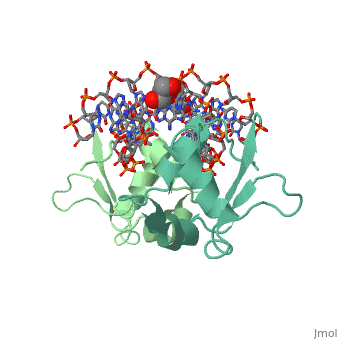3hts
From Proteopedia
(New page: 200px<br /><applet load="3hts" size="450" color="white" frame="true" align="right" spinBox="true" caption="3hts, resolution 1.75Å" /> '''HEAT SHOCK TRANSCRIP...) |
|||
| Line 1: | Line 1: | ||
| - | [[Image:3hts.jpg|left|200px]]<br /><applet load="3hts" size=" | + | [[Image:3hts.jpg|left|200px]]<br /><applet load="3hts" size="350" color="white" frame="true" align="right" spinBox="true" |
caption="3hts, resolution 1.75Å" /> | caption="3hts, resolution 1.75Å" /> | ||
'''HEAT SHOCK TRANSCRIPTION FACTOR/DNA COMPLEX'''<br /> | '''HEAT SHOCK TRANSCRIPTION FACTOR/DNA COMPLEX'''<br /> | ||
==Overview== | ==Overview== | ||
| - | The 1.75 A crystal structure of the Kluyveromyces lactis heat shock | + | The 1.75 A crystal structure of the Kluyveromyces lactis heat shock transcription factor (HSF) DNA-binding domain (DBD) complexed with DNA reveals a protein-DNA interface with few direct major groove contacts and a number of phosphate backbone contacts that are primarily water-mediated interactions. The DBD, a 'winged' helix-turn-helix protein, displays a novel mode of binding in that the 'wing' does not contact DNA like all others of that class. Instead, the monomeric DBD, which crystallized as a symmetric dimer to a pair of nGAAn inverted repeats, uses the 'wing' to form part of the protein-protein contacts. This dimer interface is likely important for increasing the DNA-binding specificity and affinity of the trimeric form of HSF, as well as for increasing cooperativity between adjacent trimers. |
==About this Structure== | ==About this Structure== | ||
| - | 3HTS is a [http://en.wikipedia.org/wiki/Single_protein Single protein] structure of sequence from [http://en.wikipedia.org/wiki/Kluyveromyces_lactis Kluyveromyces lactis] with GOL as [http://en.wikipedia.org/wiki/ligand ligand]. Full crystallographic information is available from [http:// | + | 3HTS is a [http://en.wikipedia.org/wiki/Single_protein Single protein] structure of sequence from [http://en.wikipedia.org/wiki/Kluyveromyces_lactis Kluyveromyces lactis] with <scene name='pdbligand=GOL:'>GOL</scene> as [http://en.wikipedia.org/wiki/ligand ligand]. Full crystallographic information is available from [http://oca.weizmann.ac.il/oca-bin/ocashort?id=3HTS OCA]. |
==Reference== | ==Reference== | ||
| Line 14: | Line 14: | ||
[[Category: Single protein]] | [[Category: Single protein]] | ||
[[Category: Littlefield, O.]] | [[Category: Littlefield, O.]] | ||
| - | [[Category: Nelson, H | + | [[Category: Nelson, H C.M.]] |
[[Category: GOL]] | [[Category: GOL]] | ||
[[Category: complex (winged helix_turn_ helix/dna)]] | [[Category: complex (winged helix_turn_ helix/dna)]] | ||
| Line 20: | Line 20: | ||
[[Category: transcription regulation]] | [[Category: transcription regulation]] | ||
| - | ''Page seeded by [http:// | + | ''Page seeded by [http://oca.weizmann.ac.il/oca OCA ] on Thu Feb 21 19:09:50 2008'' |
Revision as of 17:09, 21 February 2008
|
HEAT SHOCK TRANSCRIPTION FACTOR/DNA COMPLEX
Overview
The 1.75 A crystal structure of the Kluyveromyces lactis heat shock transcription factor (HSF) DNA-binding domain (DBD) complexed with DNA reveals a protein-DNA interface with few direct major groove contacts and a number of phosphate backbone contacts that are primarily water-mediated interactions. The DBD, a 'winged' helix-turn-helix protein, displays a novel mode of binding in that the 'wing' does not contact DNA like all others of that class. Instead, the monomeric DBD, which crystallized as a symmetric dimer to a pair of nGAAn inverted repeats, uses the 'wing' to form part of the protein-protein contacts. This dimer interface is likely important for increasing the DNA-binding specificity and affinity of the trimeric form of HSF, as well as for increasing cooperativity between adjacent trimers.
About this Structure
3HTS is a Single protein structure of sequence from Kluyveromyces lactis with as ligand. Full crystallographic information is available from OCA.
Reference
A new use for the 'wing' of the 'winged' helix-turn-helix motif in the HSF-DNA cocrystal., Littlefield O, Nelson HC, Nat Struct Biol. 1999 May;6(5):464-70. PMID:10331875
Page seeded by OCA on Thu Feb 21 19:09:50 2008

